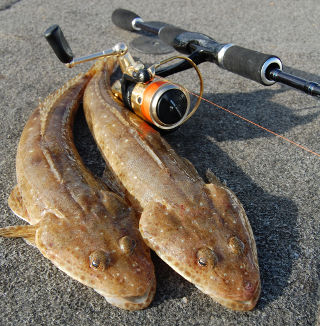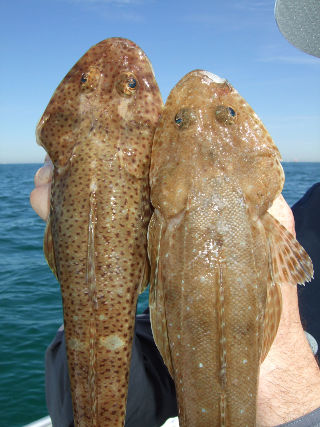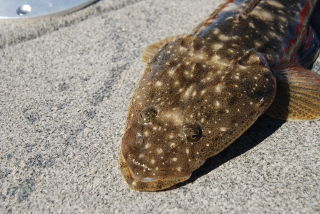Flathead
A little bit about flathead
 Also known as 'flatties' 'frogs' and 'lizards', flathead are bottom dwelling marine fish that can be found in a range of habitats in tropical and temperate waters around Australia. There are many species of flathead, but in Victoria, the Southern Bluespotted (aka 'yank' - pictured right), sand, tiger and dusky flathead
are among the most commonly targeted species by recreational fishers. The rock flathead is another species found in Victorian waters, but it is less commonly encountered by recreational anglers.
Also known as 'flatties' 'frogs' and 'lizards', flathead are bottom dwelling marine fish that can be found in a range of habitats in tropical and temperate waters around Australia. There are many species of flathead, but in Victoria, the Southern Bluespotted (aka 'yank' - pictured right), sand, tiger and dusky flathead
are among the most commonly targeted species by recreational fishers. The rock flathead is another species found in Victorian waters, but it is less commonly encountered by recreational anglers.
All these species are quite similar in appearance. However, a large black dot that is usually on the tailfin of the dusky flathead distinguishes it from its relatives that typically have a band of black stripes on the bottom half of the tailfin.
As the name suggests, these fish have flat heads and long broad bodies and are prized for their sweet, firm, and delicious white flesh. Rock flatties especially are renowned for their eating qualities and can be found on the menus of fine dining venues.
Flatties are loved by anglers big and small because most species can be caught on a range of baits and lures, and in places that makes chasing them accessible.
Where to find flathead
Dusky, sand, Bluespotted, and rock flathead live in estuaries and coastal waters across Victoria, though duskies are typically more common in estuaries - particularly near Gippsland Lakes.  Tiger Flathead (pictured right, on the left-hand side) prefer deeper water and are usually found offshore in the Bass Strait where they are typically
targeted from November to March.
Tiger Flathead (pictured right, on the left-hand side) prefer deeper water and are usually found offshore in the Bass Strait where they are typically
targeted from November to March.
All flatties are masters of ambush. They typically hide under sand and mud in spots where they can wait for the current to bring food to them and then strike quickly at passing prey.
Whether you're fishing estuary flats from the land or targeting deeper water on a boat, the key to catching them is identifying their likely hangout zones and getting your bait or lure close to the bottom. Focusing on the edges of channels, drop-offs, and weed-beds around sandbanks on a run-out tide when they're often actively feeding can be quite productive. Out on the water, using a depth sounder can help you identify ledges and deep-water pockets, and the kind of structure like rocks and weed-beds that flathead tend to favour.
Hot spots for catching flatties
- Port Phillip
- Western Port
- Corner Inlet
- Mallacoota
- Lake Tyers
- Gippsland Lakes
- Offshore – for example, in Bass Strait targeting tiger flathead.
Fishing regulations
Unless you are exempt, a Recreational Fishing Licence is needed when fishing recreationally in, on or next to Victorian waters. So, before heading on the water we'd recommend checking whether you are exempt, and if you're not, buy a licence online here.
 The bag limits, and the minimum and maximum legal sizes for flathead vary depending on which species you're targeting. To find out what the regulations are for different species, see our Recreational Fishing Guide.
The bag limits, and the minimum and maximum legal sizes for flathead vary depending on which species you're targeting. To find out what the regulations are for different species, see our Recreational Fishing Guide.
Given how similar many species of flathead look, it's important that you identify the fish correctly so you can stay on the right size of the rules. Remember, check the tail of each fish - Dusky flathead (pictured right) usually have one black dot on their tailfin, and don't have any dots or dark bands at the bottom on their tailfin like the other species typically do.
Flathead don't have a closed season so you're free to fish them all year round. However, the warmer months seem to be better when fishing for flatties.
Baits and lures
Flathead will eat a range of baits, so make sure you take a few varieties with you to increase your options if they're being a bit picky. Squid, and stronger smelling baits, like pilchard, bluebait and whitebait stay on the hook quite well and are good at attracting flathead. The key to success is finding the right flathead habitat and getting them on the bottom where the fish are laying in wait for food.
Fishing lures are made to tempt a fish in two ways: by imitating small fish, crustaceans, and natural prey fish eat, and attracting them through colour, movement and/or reflective surfaces. There are a range of different lures on the market, however, for catching flathead we'd recommend focusing on three types: soft plastics, lipless crankbaits, and trolling lures. It's worth noting that flatties will also eat flies. So, if you fancy fly-fishing for them, then wading the estuary flats with a weight 6 or 7 fly rod, weight forward floating line, and some Clouser style minnow patterns can work a treat.
Fishing soft plastics for flatties is great fun and picking patterns with lots action such as paddle tail plastics and curl tail grubs can be deadly. The benefit of fishing soft plastics is that it's easy to change jig heads to match the depth at which you're fishing.
Lipless crankbaits come in an array of sizes, colours and materials and can be very effective when fished off the beach. These types of lures sink quickly, vibrate when lifted, and they're easy to fish.
With both lipless crankbaits and soft plastics, the retrieve is important for getting the fish to bite. A 'hop and stop' retrieve where you bring the line back with a simple rod lift, aiming to get it a metre off the bottom, before letting it sit for a few seconds to hit the bottom again mimics the movement of prey and can result in bites.
Finally, if you're fishing from a boat, then trolling lures can be deadly. Trolling lures are usually bibbed (the bib forces them to travel at different depths under water depending on the angle of the bib) that come in a range of sizes, colours and importantly depths. The key to success is matching the depth of lure to depth of water you're fishing so you're hitting the bottom and working the likely looking flathead zones thoroughly.
Rods
The good thing about catching flathead is that you don't need a particularly expensive or complicated outfit. A quality fast action 2-4kg rod with 2000-2500 size spin fishing reel spooled with 10 lb braid and 15 lb monofilament (or fluorocarbon) leader would work well.
If you're bait fishing, a simple running sinker rig is perfect. You can use pretty much any size (within reason!) and style of hook when bait fishing, just remember to alter the size of your sinker depending on the strength of the current for the best results.
If you're luring flatties, spooling your rod with a slightly lighter braid (8 lb) and an 8-12 lb fluorocarbon leader will help you cast the lure longer distances, and the tougher outer coating on the fluorocarbon can give added protection against the flathead's raspy teeth.
For a quick intro into fishing for flathead, particularly duskies, watch the video below.
Responsible fishing handling
If you catch a fish, it's important you handle it responsibly to minimise stress and maximise its chance of survival if you intend to release it.
We would recommend that:
- You handle the fish with wet hands or a wet towel (which is a very good option for fish with spiky fins like flathead) on a cool, wet surface.
- Remove hooks as cleanly as possible using a hook remover or long nosed pliers.
- If the fish is hooked deeply in the mouth or stomach, leave the hook where it is and cut the line as close as possible to hook.
- When possible, remove the hook while the fish is still in the water.
- Hold the fish gently move it forward to force water through its gills until it has revived and is able to swim normally.
If the fish is of legal size and you intend to keep it, we recommend that:
- Dispatch fish you intend to keep immediately.
- Ice fish and store them away from sunlight, preferably in a moist bag or cooler.
For more information on responsible fish handling visit our web page on responsible fishing behaviours.
